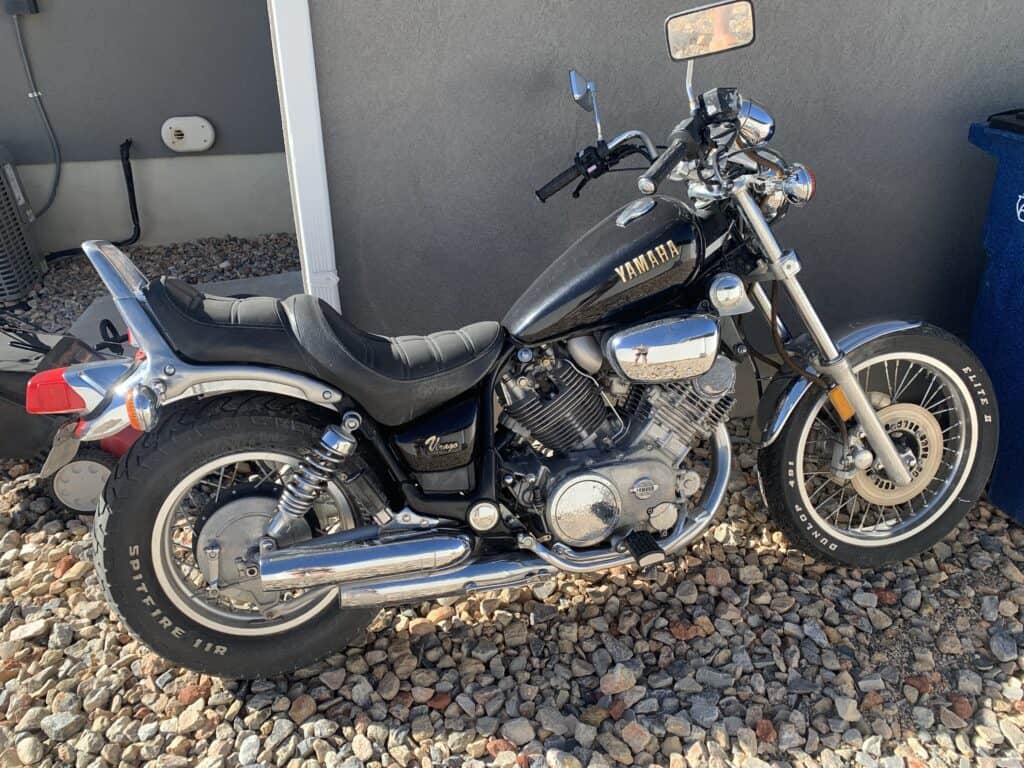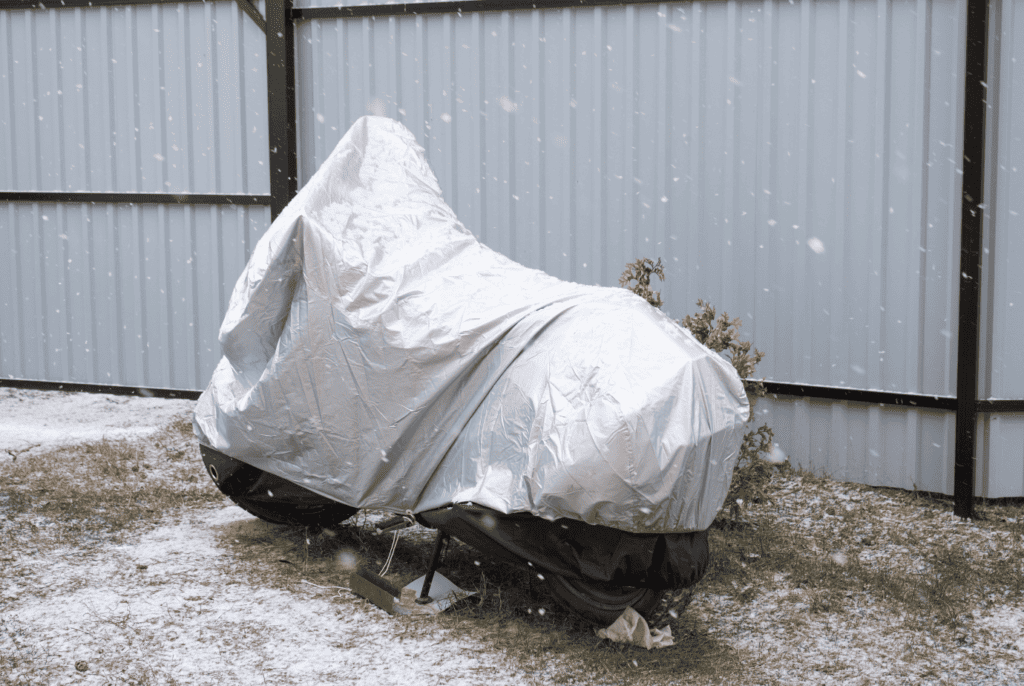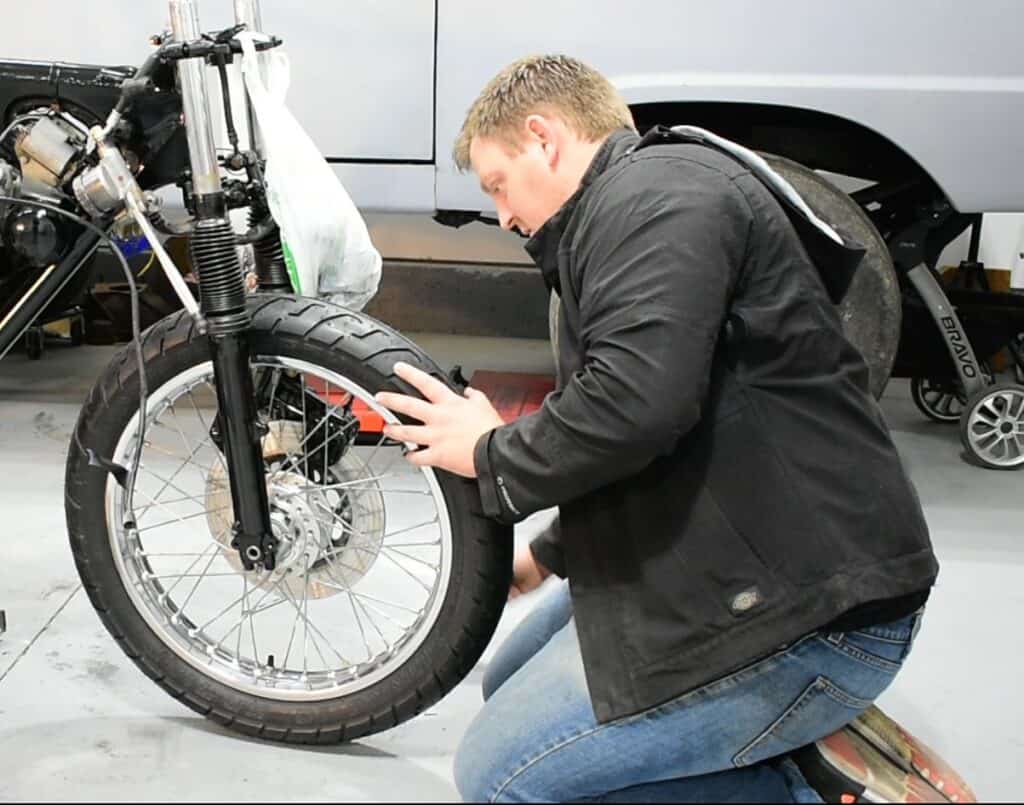
Well, winter has come (or at least you’re thinking about it coming!). And with that, you may be wondering how you can store your motorcycle for the season.
It is most ideal to store a motorcycle in a covered area, such as a garage or shed, when winter hits since these places provide the most protection. But some of us aren’t fortunate enough to have these places to store our motorcycles which leaves outside storage the only option. Many may wonder if that’s a safe and legitimate way to store a motorcycle.
So, can you keep a motorcycle outside in the winter? Yes, you can keep a motorcycle outside in the winter. For this to be possible, it needs to be properly prepared for the season and dressed with a good, reliable cover to prevent any water or moisture from getting in places that could cause damage.
Many people don’t realize how important it is to take the proper steps to storing a motorcycle for the winter, especially if you plan on keeping it outside the whole time. There’s a lot more to it than just putting a cover on and calling it good, so let’s dive into it.
Mastering Winter: A Comprehensive Guide to Storing Your Motorcycle Outside Safely
When I was in college, I lived in northern Utah and owned a motorcycle restoration business. I usually had several bikes at once and needed to store them. Being a college student, I didn’t have access to a garage and often stored these motorcycles outside during those harsh winters. I learned a thing or two about how to properly do this.
Though keeping a motorcycle in some sort of shelter during the winter is the most ideal way to maintain a motorcycle, it’s completely possible to yield the same results keeping a motorcycle outside throughout the whole season. Here’s how to do it:
Oil
The first thing you’ll need to do is change the oil. Some people assume it’s best to just drain the oil until spring, however that isn’t a good idea because any empty chamber you leave inside the engine gives opportunity for moisture to build up. Also, old/used oil inside the engine has impurities that could clog up oil passages if it sits for long periods of time.
Gas

The next thing you’ll need to do is top off the gas can. Again, leaving any sort of empty space in any chamber during the winter will increase chances of moisture building up. Add some stabilizer in the gas and let the motorcycle run for a few minutes so the stabilized gas has a chance to run through the whole fuel system.
Most of the motorcycles I buy are from people who stored their bikes outside during the winter and can’t get it to start up in the spring. This is usually a carb problem because the unstabilized gas clogged it up. An easy fix for me, but annoying for the original owner.
Battery
Next, you’ll want to pay attention to the battery. The first option you have is to completely remove it and store it inside with you to prevent it from freezing. The second option would be to hook it up to a battery tender so it maintains it’s charge throughout the season. If you do this, ensure the tender is covered as well so snow and moisture won’t ruin it.
Tires
Don’t forget to give those tires some attention. Parking your motorcycle on something softer, such as dirt or a section of carpet will help prevent those flat spots. The other option you have is using the center stand to take the pressure off at least one tire. The next option you have is using tire stands that will elevate both tires.
Security
Keeping your motorcycle outside during the winter makes it possible for it to get stolen. Use some sort of security or alarm system on your motorcycle.
There are several different kinds of locks you can fasten to the rim of the tires. There are also alarms specifically made for motorcycles that will loudly alert anyone close by that someone is messing with your motorcycle. Click here to see my list of recommended security products for a motorcycle.
Cover

One of the last steps you’ll need to take if you’re going to keep your motorcycle outside during the winter is covering it. This is probably the most important step and must be done right if you don’t want to run into problems come spring time.
Purchase a good, quality cover to go over your motorcycle. I would recommend a waterproof, cloth-free cover. Make sure it covers your whole motorcycle, leaving no chance of water getting inside. Fasten or tie it down to your motorcycle in several places so it won’t blow away in the wind.
Some covers come with elastic ties that can do this for you. I recommend the Dowco Guardian cover which can be found here on Amazon. If you do this right, your motorcycle will be as good as new once it starts warming up.
Insurance
Lastly, I highly recommend lay-up insurance if you plan on storing your motorcycle outside for the winter. This type of coverage will help in the case your motorcycle gets damaged while sitting. Keep in mind this is for dormant motorcycles and will not provide coverage on the road. For insurance options specific to you, see our other page here and compare rates.
What Happens To The Fluids During Improper Winter Storage
Now that we understand how to properly keep your motorcycle outside during the winter, let’s discuss what happens to a motorcycle when it’s kept outside during the winter without properly preparing it.
When kept outside during the winter, the fluids in a motorcycle start to change. The fluctuation between freezing temperatures and above freezing temperatures changes the chemistry of the gas. If a stabilizer isn’t added before the season, the gas can potentially “gunk” up which will ultimately clog the fuel system, especially the carburetor if you have one.
Also, when the fluids are not topped off before winter, condensation and moisture will sneak into the empty spots and can potentially cause some rust. Moisture getting in the fluids will also potentially cause the motorcycle to malfunctions when you go to start it up.
It will help to occasionally start up your motorcycle throughout the winter to flash off the condensation and keep your motorcycle’s internals exercised. You can read more about starting up your motorcycle during the winter by reading our other article here.
What Happens To The Gaskets, Seals, And Tires During Improper Winter Storage

As stated before, tires can get flat spots on them if left untreated and parked on concrete. This happens for several reasons. The pressure of the weight of the motorcycle is constantly pushing down on the tires. Normally that’s okay because when you frequently use the motorcycle, the weight is evenly distributed throughout the whole tire. But when stationary, the pressure builds up all on one spot.
In addition, the freezing temperatures will deflate the tire pressure a little which gives less resistance to the weight that’s being pushed down on it.
Gaskets and seals are already at risk not being used during the long winter months. If you keep your motorcycle outside for the winter and don’t change the oil beforehand, the old/used oil has potential to gum up oil passages because of the impurities.
Normally, regularly used gaskets and seals would be able to combat this. But since your motorcycle is most likely remaining dormant throughout the winter months, those gaskets and seals aren’t being heated up and stretched and may become slightly brittle already.
What Happens To The Drivetrain During Improper Winter Storage
The drivetrain on your motorcycle, meaning the engine, transmission, and chain, is one of the most important elements on your motorcycle and will receive the most damage if not properly taken care of when left outside for the winter.
The main and most obvious problem that will happen to the drivetrain on a motorcycle is rust. All the moisture from the rain and snow will creep inside the engine and transmission and will settle on the chain. Rust will quickly begin to form both on the outside and the inside, especially if your motorcycle is getting splashed with road salt.
It’s possible to take care of surface rust you may see on the outside, but rust can cause damage if it starts forming on the inside of the engine and transmission. Rust has the potential to seize the engine because it will stick the pistons in place.
Rust can also damage the chain so much that it will break the chain once you go to start it. Moisture can also rust together bearings and gears which means an expensive fix for you. All of this can simply be prevented by placing a cover over the motorcycle to keep the moisture out. A lot of people don’t realize the damage water can do to a motorcycle if you let it sit outside.
Conclusion
It is completely possible to store a motorcycle outside during the winter. However, the proper steps should be taken or else your motorcycle could be hugely impacted by the cold weather and moisture. Ensure the fluids are topped off, the tires are elevated, and a quality cover is used. If you follow these steps, you’ll be sure to have a motorcycle that starts right up in the spring!
Related Questions
What are some reasons a motorcycle won’t start? There are several reasons why a motorcycle may not start, some of the common reasons being a dead battery, clogged carburetor, bad spark plugs, a bad starter, and cracked spark plug wires. Click here to read our article that discusses this in more detail.
How long is too long for a motorcycle to sit without starting it? A motorcycle should never sit longer than a month without starting it or without properly storing it. A motorcycle can start accumulating some major issues if it sits for longer than that. It is possible to revive a motorcycle that has been sitting for years but it will require a lot of work.
